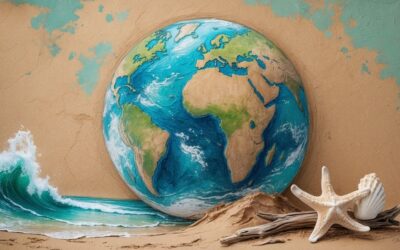The Gist
Thunderstorms are one of nature’s most electrifying and powerful displays. They’re awe-inspiring to watch, with their dark clouds, sudden bursts of lightning, and rumbling thunder echoing in the distance. But while they’re breathtaking, thunderstorms are more than just dramatic weather events. They remind us of the raw power of nature, capable of both creating beauty and causing destruction. Understanding how thunderstorms form and behave is not only fascinating but crucial for staying safe during these intense weather phenomena.
The Science Behind Thunderstorms
At the heart of every thunderstorm is a powerful combination of moisture, unstable air, and lift. These three ingredients are key to the formation of thunderstorms. When warm, moist air rises and cools, it condenses into clouds. As more moisture gathers, the cloud grows, forming towering cumulus clouds. Eventually, when conditions are right, this mass of energy transforms into a thunderstorm.
Lightning, one of the most striking features of thunderstorms, occurs when electrical charges within the cloud build up. These charges create an imbalance between the cloud and the ground or within the cloud itself, causing a powerful electric discharge. That’s when you see the flash of lightning, followed by the roar of thunder as the air rapidly expands and contracts.
To give you an idea of how intense this process is, lightning can heat the air around it to over 50,000 degrees Fahrenheit—hotter than the surface of the sun! This incredible heat is what causes the rapid expansion of air, creating that distinct thunderclap.
Why Thunderstorms Matter in Real Life
Thunderstorms aren’t just captivating displays; they play an essential role in balancing the Earth’s energy and maintaining the water cycle. Rain from thunderstorms helps nourish crops, fills rivers, and sustains ecosystems. But they also remind us of nature’s unpredictability and potential danger. Thunderstorms can lead to flash floods, hailstorms, and in some cases, tornadoes.
In many places, thunderstorms are common during the summer months when the atmosphere is more unstable due to the intense heat. For example, regions like the Midwest in the United States experience frequent storms, known as “thunderstorm season.” Understanding how these storms form can help us better predict and prepare for them.
Real-Life Examples of Thunderstorm Impacts
Consider how thunderstorms can impact daily life. In some areas, they cause power outages, damage to buildings, or even personal injuries. Lightning strikes alone can disrupt entire power grids, and they are a leading cause of wildfires, particularly in dry regions. For example, in California, dry thunderstorms—storms with lightning but little rainfall—have been known to ignite wildfires that spread rapidly across dry landscapes.
On the other hand, thunderstorms are also responsible for delivering much-needed rain in drought-prone regions. Countries like India rely on the monsoon season, where thunderstorms bring life-giving water to crops and replenish reservoirs.
Whether it’s the relief of rain after a hot day or the disruption of daily activities due to a storm, thunderstorms affect us in many ways, making it essential to understand their power and how to stay safe.
Safety Tips During Thunderstorms
Thunderstorms are magnificent, but they can also be dangerous. Knowing how to protect yourself during a storm is critical:
- Stay Indoors: The safest place to be during a thunderstorm is inside a sturdy building. If you’re outside, seek shelter immediately.
- Avoid Electrical Appliances: Since lightning can travel through electrical wiring, it’s best to avoid using electronics like computers or televisions during a storm.
- Steer Clear of Windows: Strong winds and flying debris can make windows dangerous during a storm. Stay away from them to avoid injury.
- Don’t Stand Under Trees: While it might seem like a safe place to hide, trees can attract lightning. If you’re caught outside, try to find low ground instead.
By following these simple guidelines, you can enjoy the beauty of a thunderstorm from a safe distance without putting yourself at risk.
Take Action: Embrace Nature’s Power, But Stay Safe
Thunderstorms offer us a chance to witness the raw, electrifying power of nature. They serve as reminders of how interconnected we are with the natural world and how weather can shape our environment and daily lives. So, next time you hear the rumble of thunder or see the flash of lightning, take a moment to appreciate the science and beauty behind the storm.
But while you admire nature’s power, remember the importance of staying safe. The forces at work in a thunderstorm are beyond human control, but understanding how they operate gives you the knowledge to protect yourself and those around you. Stay curious, stay informed, and most importantly, stay safe during these electric displays of nature’s might.
Expand Your Vocabulary
- Thunderstorm: A storm with thunder and lightning, usually accompanied by rain or hail. In everyday use, you might say, “We should hurry inside; a thunderstorm is approaching.”
- Cumulus clouds: These are large, fluffy clouds that often signal the beginning of a thunderstorm. In a sentence, you might say, “Those cumulus clouds look like they could turn into a storm any minute.”
- Lightning: A sudden discharge of electrical energy during a storm, resulting in a bright flash. You might hear, “The lightning last night was so bright it lit up the entire sky.”
- Thunderclap: The loud noise produced by rapidly expanding air after a lightning strike. In daily language, you could say, “The thunderclap startled me awake during the night.”
- Imbalance: A situation where things are not equal or stable. In the context of thunderstorms, it refers to the difference in electrical charge that leads to lightning. You might use it to describe any unequal situation, like “There’s an imbalance in how the work is distributed among the team.”
- Flash flood: A sudden and intense flooding event caused by heavy rain. People often say, “The downpour turned the streets into rivers, causing a flash flood.”
- Tornado: A violent rotating column of air extending from a thunderstorm to the ground. You could use it metaphorically, like “His room looked like a tornado hit it!”
- Drought: A prolonged period of abnormally low rainfall. You might hear it used to describe not just weather but a lack of something, like “There’s been a creative drought in my writing lately.”
- Electrical discharge: The release of electrical energy, such as during a lightning strike. In everyday English, it might be used to describe static shocks, like “I felt a little electrical discharge when I touched the doorknob.”
- Unstable air: Air that rises easily, which can lead to storms. You might use it metaphorically to describe an unpredictable situation, such as “The political climate is as unstable as the air before a storm.”
Let’s Talk
- Have you ever been caught in a thunderstorm? How did it make you feel, and what did you learn from the experience?
- Thunderstorms are both beautiful and dangerous. How do you balance admiring nature’s beauty while staying safe?
- Why do you think thunderstorms are more common in certain areas than others? How might geography or climate play a role?
- The concept of an imbalance leading to lightning is interesting. Can you think of other situations where imbalance leads to sudden and powerful outcomes in life or nature?
- Thunderstorms bring both rain and destruction. How can this dual nature of thunderstorms help us think about challenges in our lives that come with both positives and negatives?










0 Comments